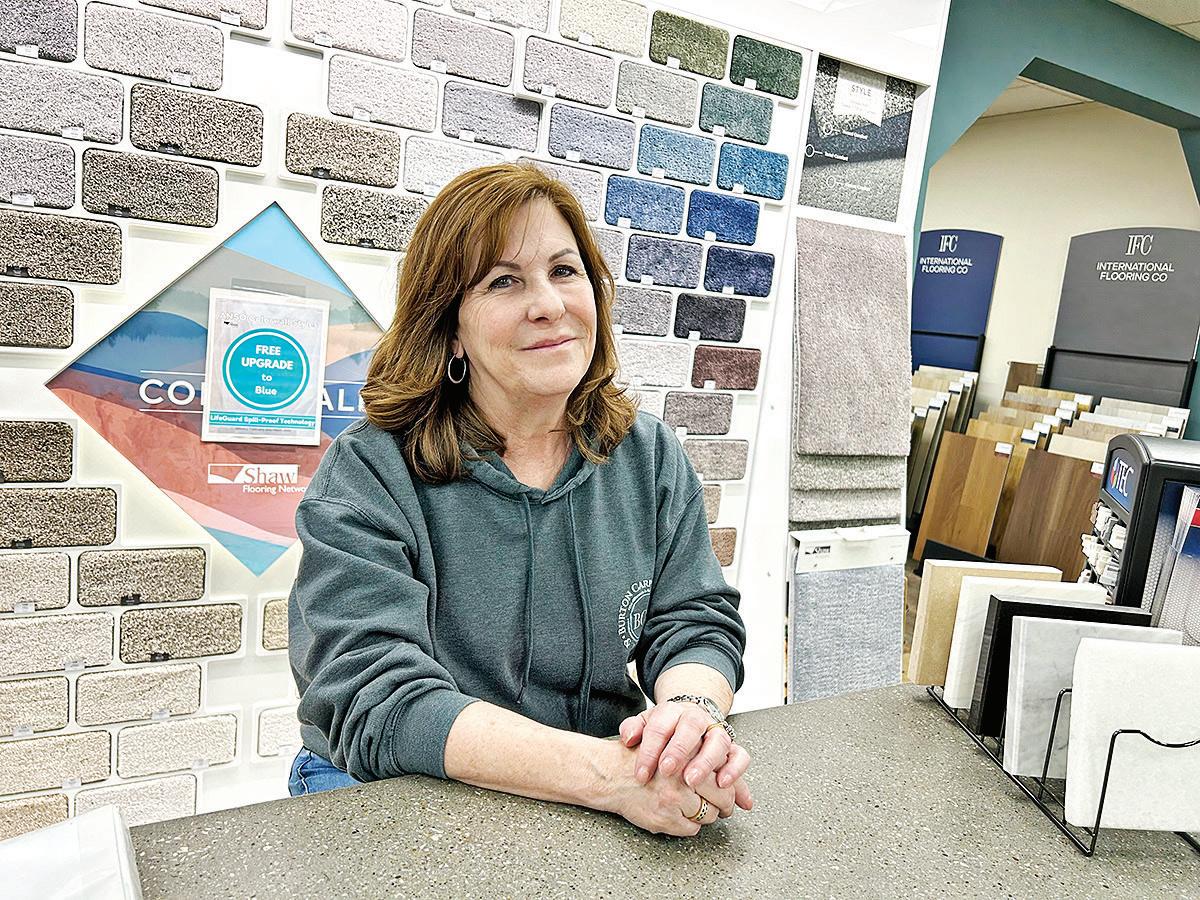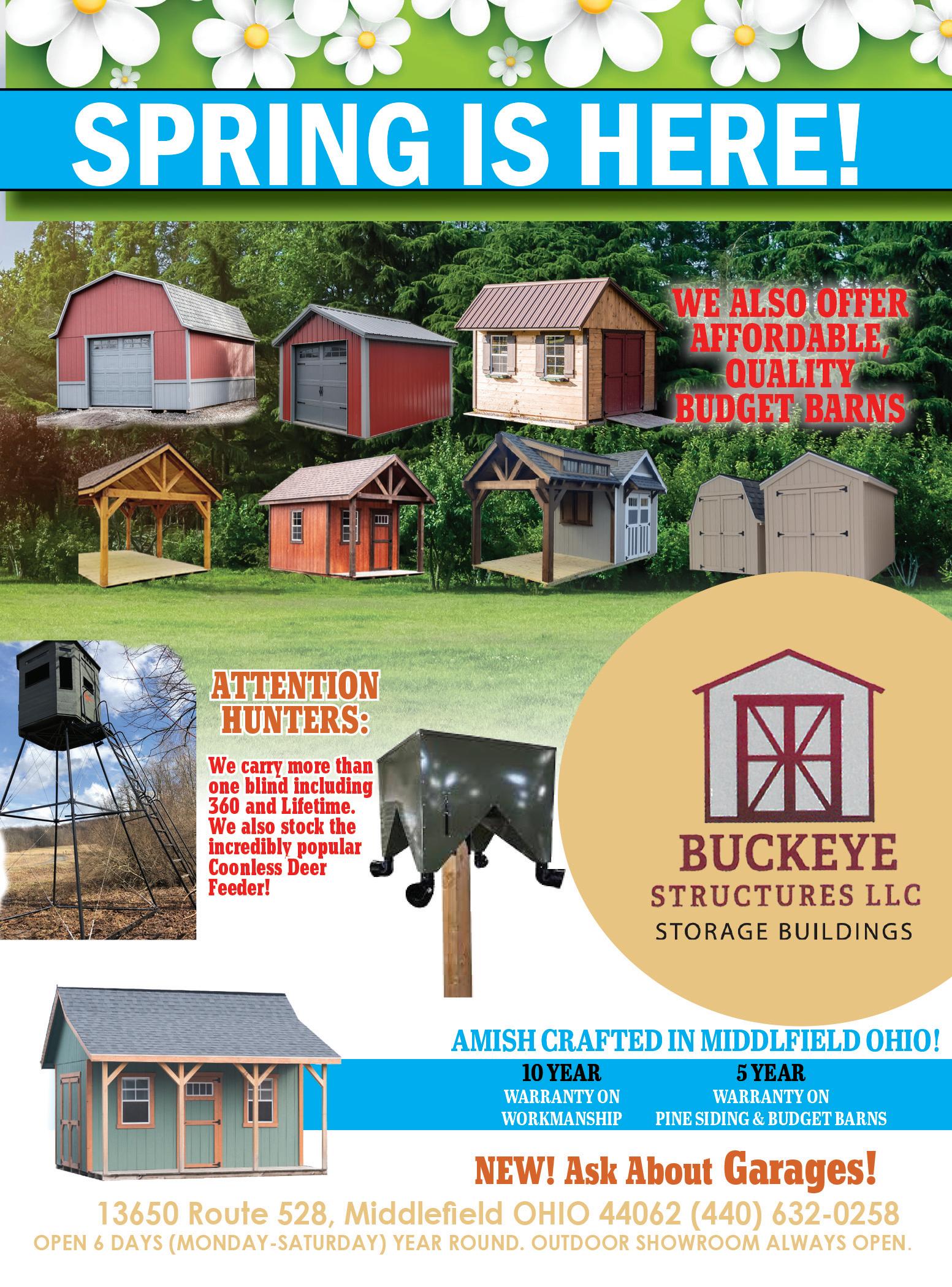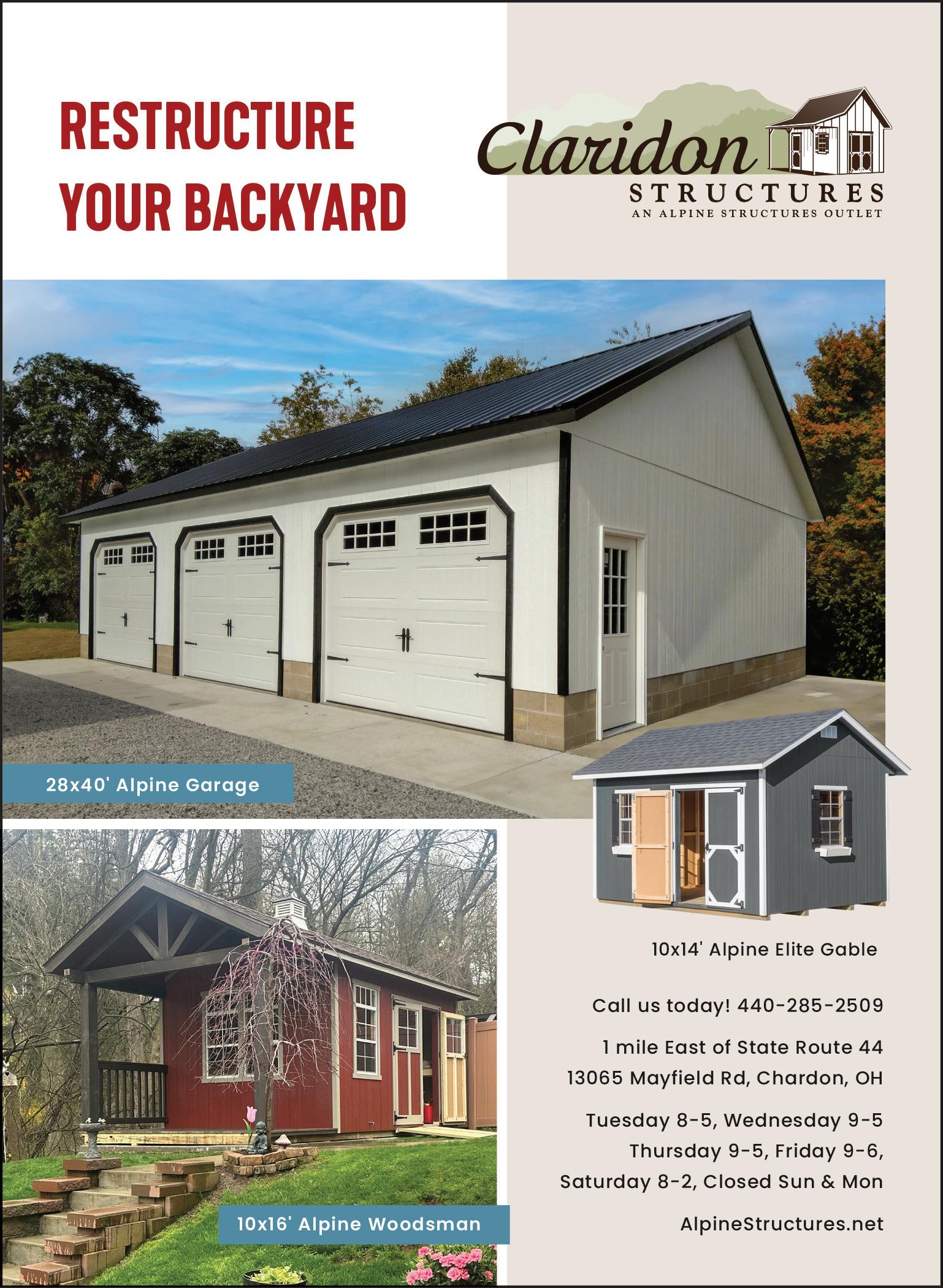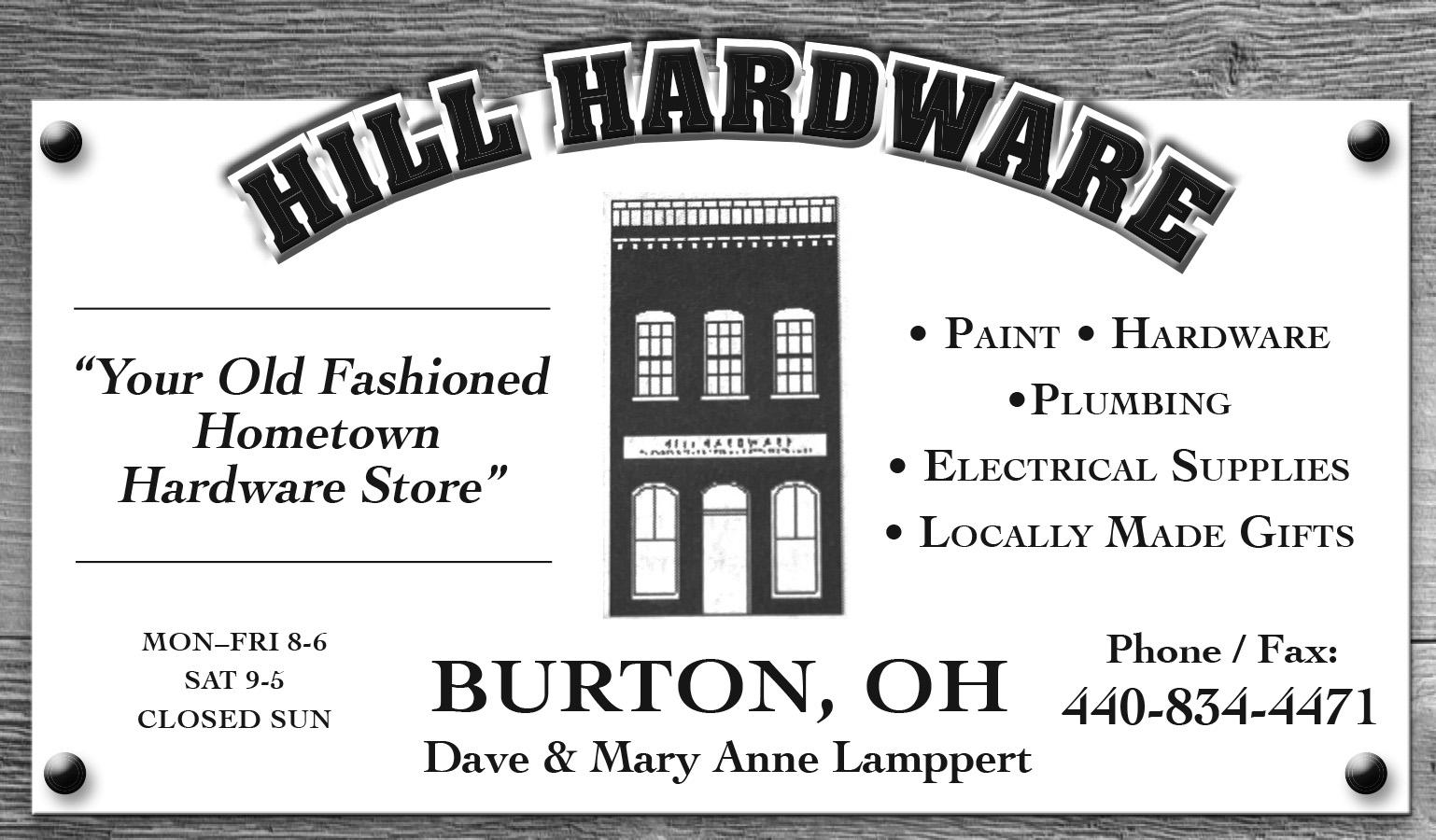




By Ann WishArt Ann@kArlovecmediA
Businesses planted in Geauga County as far back as 1958 have grown and prospered through the hard work and perseverance of the generations.
Three of these family-owned operations weathered the vagaries of COVID-19 and the economy and are thriving today, thanks to the quality of their products and customers who keep returning, year after year, for mate rials and service.
Displays in big-box stores in Northeast Ohio pale in comparison to those available at Burton Carpet Shoppe, First Quality Power Place and Hardwood Lumber Company.
Burton Carpet Shoppe
Started inside the red barn behind the Burton Public Library in 1983, Burton Car pet Shoppe has found its niche in a brick business condo on Kinsman Road just west of state Route 44 in Newbury Township.

Carrie Giel said her father-in-law, Fred Giel, was a carpet installer for the Higbee’s department store in Cleveland.
In the early 1980s, he and his wife, Lucy, decided there was a market for carpet in Geauga County and set up the warehouse in the village, Carrie said.
The operation grew and in the late 1990s, they moved to the more spacious, easy-to-find building in Newbury, she said.
Today their son, Mike, and Carrie run the business with Jason Heiden and Jaime Lawson, who are the third generation to work in


architectural design such as these Ionic columns created at HLC are one of his many interests.
the family business.
“Our son and daughter have been in it for years. We’ve been really blessed,” Carrie said, adding there are two grandchildren apprenticing at Burton Carpet Shoppe, as well.
The showroom provides customers with plenty of options for flooring, from lush carpet to vinyl and wood plank to tile, laminate

and prefinished hardwood.
But customers, both residential and commercial, get more for their money than carpet. Advice from Carrie, drawn from years of experience, can be vital to creating a satisfactory finished product.
“Besides giving people the benefit of our knowledge, we can help them with style and
color,” she said. “The big-box stores are not going to give you all the information you need (about) the sub floor and moisture levels.”
Carrie will visit a potential site to offer hands-on suggestions.
“If the product is not right, I will tell the customer why. I give them the knowledge to See Businesses • Page 4




from page 3
make the right choice. It’s just the right thing to do,” she said.
Once the foundation is laid, installers are scheduled.
“We tailor each project based on the client’s needs,” Carrie said, adding the crew will move furniture and do clean-up when the job is done, meeting customer’s expectations.
“We’re flexible,” she said.
Including Mike and Carrie, Burton Carpet Shoppe has 10 full-time employees who stay very busy, she said.
“We could be much larger,” Carrie said, adding, however, their focus is on quality. “Our guys do continuous education, learn new installation methods. The technology is changing constantly.”
Plans for growth include adding a cafe at the back of the showroom where kids can snack and watch television while parents make those home-altering decisions, Carrie said.
Located at 16891 Kinsman Road in Middlefield Township, First Quality Power Place is owned and operated by Dan Johnson, the second generation to provide and service almost any kind or make of lawn and garden equipment imaginable.
The showroom is packed with bright, new mowers, weed whips, chain saws, log splitters, tillers, leaf blowers and more — all in demand since spring is finally peeping over the horizon.
His father, Don Johnson, was originally in the firewood business, Dan said.
The market, when he opened First Quality Power Place in 1981, revolved around selling and servicing multiple brands of chainsaws.
Since Dan took over the business in 2010, he has expanded the inventory. With his 44 years experience and his trained service technicians, most problems that come through the door can be solved, he said
“We service all the equipment we sell and some others,” Dan said, adding his service department is in strong demand by Amish families and logging companies in the area come to him for equipment and supplies.
He also sees an uptick in business related to the many landscaping operations that take care of estates in Geauga and Cuyahoga counties.
“The arborist market has definitely grown over the last five years or so. We have a lot of repeat customers and we take care of them,” he said. “Service after the sale is the thing.”
The business ebbs and flows with the seasons. In February of 2024, people started buying new equipment and making sure the older mowers and tillers were ready for the spring, Dan said.
Winter lasted longer this year, but do-ityourselfers and lawn care professionals are showing up now.
“Now is the time to get equipment serviced for a trouble-free mowing season,” Dan said.
Another second-generation business on Station Road in Middlefield Township, Hardwood Lumber Company, has morphed since its birth in 1958 into four related operations in one location.
Stephen Trudic Jr. owns HLC, Sheoga Floor and Paneling, Inc., HLC Cabinets and Mouldings One on the steep hillside above the Cuyahoga River.
His father, the late Stephen Trudic Sr. bought and sold lumber in the region before starting the sawmill 57 years ago.
Since then, the huge buildings, some decorated with murals, have grown and evolved. HLC acquired the neighboring St. Nick’s Brush Co. and turned it into Sheoga.
Trudic took over the business eight years ago and, by adding the cabinet operation and Mouldings One, turned it into a “one stop shop” for individuals or contractors looking for custom flooring, cabinets, moldings, counter tops, doors and stair treads, Trudic said.
HLC has become a nationally-recognized producer of quality butcher block countertops, epoxy tables, live edge slabs, floating shelves, architectural millwork, stair treads, risers and much more, according to its website.
Trudic credited his late mother, Lee Trudic, with recognizing the value of online sales more than 20 years ago and creating the original website.
“She was proactive with computers,” he said, adding the online presence gave HLC a platform from which sales took off.
Trudic said the four operations employ 160 people, about 90% of whom are Amish, and he envisions the conglomerate growing into the future.
“I’m actually having a lot of fun,” he said. “These are exciting times.”
Expansion of the HLC is ongoing with each office trimmed with different molding.
“I have a passion for architecture,” Trudic said, pointing out facades on some of the outside doors that are reproductions of Ionic pillars.
An extensive cabinet showroom is underway with the design reflecting his fascination with historic architecture
"My goal has always been to share historical examples of millwork and carpentry, breaking the work into its various parts and moldings to make it easier for us to understand,” Trudic said on his website. “I believe great design is only possible by studying works of the past."

Air conditioners are a lifeline come the dog days of summer, when soaring temperatures make a well-cooled home a welcome respite from the outdoors. Maintaining an AC unit ensures it will be there to keep everyone cool when the mercury rises. The following are some steps homeowners can take to keep their AC units in tip-top shape this summer.
• Replace the air filter on the unit. Dirt, dust, debris, and pollen can quickly fill the filter on an AC unit. Replacing these filters prior to summer can make the unit operate more efficiently and keep cool air circulating throughout the house all summer. Homeowners can first identify which type of unit they have and then find an online tutorial to see how to replace the filter. Some filters are more expensive than others, but the cost is still low and the energy savings can be substantial.
• Schedule annual maintenance on the unit. Routine maintenance performed by a local HVAC technician is another way to ensure an AC unit is running at peak capacity when it’s most needed. Such maintenance is perhaps most effective in spring, as that ensures the unit is running strong from the first heat wave of the summer all the way through Labor Day. HVAC technicians can identify problems and recommend services that homeowners may not recognize they need until it’s already hot out. Annual maintenance appointments also give HVAC professionals a chance to assess a system compared to the previous year, which can help them identify if a unit is nearing its end. That can ensure homeowners are not caught off guard when the unit needs to replaced.
• Help the unit make it through the summer. Whether it’s a typical summer or one marked by a handful of heat waves, AC units can use a little help to get through the season. Closing curtains throughout the house on hot afternoons is a natural way to keep a

home cool during a heat wave, and that can cut back on home cooling costs and protect a unit from being overworked. Ceiling fans also can be installed to keep rooms cool and circulate air, which also makes a hot summer a little less taxing on an AC unit.
• Use a programmable thermostat. Programmable thermostats allow homeowners to set the temperatures inside their homes throughout the day. If no one is home during the afternoon, there’s no reason to have the AC cranking. Program the thermostat so the house is comfortable when people are home, but raise the desired temperature when no one is around. That gives the AC unit a break during the day and can help to dramatically reduce the cost of cooling the home.
AC units will not last forever, but some simple maintenance can improve their life expectancy and keep homes comfortable throughout the summer.






metrocreAtive
As any seasoned party host knows, guests can sometimes overstay their welcome. But what about guests that were never welcome in the first place? Pests can wreak havoc on a home, contributing to significant and costly damage and potentially exposing residents, particularly pets, to harmful illnesses.
Pest infestation can occur any time of year, but homeowners may be most likely to see signs of infestation during spring cleaning sessions in areas of the home where they didn’t spend much time in the previous months, such as attics and garages. As spring cleaning season kicks off, individuals can keep an eye open for the following signs of pest infestation.
• Nesting materials: Pests may drag certain nesting materials from outdoor areas into a home. Leaves and grass clippings as well as twigs may be used to construct a warm nest in interior spaces. Pests also transport nesting materials that are inside a home to other areas of a home that are more secluded. Fabric, paper products, including chewed cardboard, and insulation seen in unusual spaces may be left behind by pests nesting in other areas. If there’s a trail of such materials, follow it to see if you can find a nest.
• Pets behaving strangely: Pets can’t tell their owners if there’s pests in a home, but they may exhibit signs suggesting an infestation. Pets may start scratching at walls and doors with their paws or sniffing around areas where they can smell pests.
• Unexplained odors: Foul odors are not necessarily indicative of a pest infestation, as such aromas could indicate a range of issues. But pest feces can produce a foul odor, and some pest infestations can lead to mold growth that also produces unpleasant smells.
• Destroyed items: Certain pests may gnaw or chew on items, including electrical wires, home furnishings and food packaging. Homeowners who keep a stocked pantry of dry goods and notice packages have been damaged or chewed through likely have a pest infestation.
• Droppings: Of course, droppings are a telltale indicator of a pest infestation. Rodent droppings are small, black and shaped like a grain of rice. Pests such as termites might leave pellet-shaped droppings in their wake.
Signs of pest infestation may be discovered during spring cleaning sessions. If homeowners suspect pest infestations in their home, they can examine out-of-the-way spaces with a flashlight and contact a pest control specialist to identify and address any issues they uncover.


Real estate has long been touted as a worthy long-term investment. With that conventional wisdom in mind, young adults often make buying a home one of their first big-ticket purchases. Though real estate remains a potentially lucrative investment, the market for homes has been difficult to navigate for several years running.
High mortgage interest rates and low inventory have left many buyers feeling priced out of the real estate market. Others may find the competitive nature of the modern real estate market too stressful. No one can predict if or when the real estate market might be less challenging, but the following are some ways those looking for a house can navigate that process.
• Ready your finances. It goes without saying that prospective buyers must get their financial affairs in order before they begin shopping for a house. But finding a home in the current market takes time, and some buyers might have let their mortgage preapproval letter expire without realizing it. Others might have experienced a dip in their credit rating as they turned to credit cards to confront inflation. That means buyers who began looking for a home months or even years ago might not be positioned to buy now should they find a home to their liking. Revisit your finances if it’s been awhile. Pay off any consumer debt that has accumulated in recent months and reapply for mortgage preapproval if necessary.
• Be ready to pounce. Data from the National Association of Realtors found that
the average home spent 32 days on the market before being sold in November of 2024, which was a full week longer than a year earlier. That’s good news for buyers, but it still means buyers must be ready to pounce if they find a home and home price to their liking.
• Hire a real estate agent. The hectic pace of the modern real estate market can be difficult for anyone to keep up with. But real estate agents keep up with the market for a living, and they can be invaluable resources for buyers whose commitments to work and family are making it difficult to keep pace.
• Emphasize long-term growth and value when assessing properties. According to Zillow, the median list price of homes in the United States was just under $387,000 by the end of January 2025. But buyers must
also recognize that 22.4 percent homes sold above list price in that month, according to a Redfin analysis of MLS data and/or public records. Buying a home is more than an investment in a property. It’s also in some way an investment in the town where the home is located and in a homeowners’ future. So while it can be tempting to buy a home with the lowest asking price, home buyers should also seek homes that figure to experience the best long-term growth in value. Homes situated in safe and welcoming towns with good schools are arguably a better investment than homes with lower sticker prices but no such amenities.
The real estate market has been challenging for buyers over the last several years. Various strategies can help buyers find a home that suits them and their budgets.
A kitchen is widely recognized as the most popular room in a home. Though it might be true that the hustle and bustle of home life runs through the kitchen, many a memory is made in the living room as well.
Living rooms tend to be go-to spaces for family movie nights, game watches with fellow fans and places to gather during holiday celebrations. That’s a lot of quality time spent in the living room, and those moments can be more enjoyable if the space is as comfortable as possible. With that in mind, people can consider various ways to make living rooms
more comfortable.
• Prioritize comfort over aesthetics. In an era of Instagram, it’s easy to fall head over heels with images when designing a living room. Aesthetic appeal certainly has its place in a living room, but it’s important to remember how much living will be done in these rooms when designing them. Comfortable couches and furnishings like ottomans can make it easier to relax in the living room whether you’re watching a movie, cheering on your favorite team or reading a book.
• Ensure there’s ample seating. It can be hard to feel comfortable in cramped quarters whether you’re welcoming friends and fami-
ly into your home or simply lounging around on Sunday mornings. If comfort is your top priority, arrange the room so there’s ample seating throughout and people don’t feel like they’re sitting on top of one another when spending time in the room.
• Consider neutral paint colors. Furnishings are not the only things that can affect how comfortable people feel in a living room. The home improvement experts at The Spruce note that neutral paint colors with warm undertones help to establish a cozy feel in a living room. Various shades of white, beige, tan, or even gray can help to establish a warm, comfortable vibe in a living room.
• Incorporate the outdoors into the room. The great outdoors can have a calming effect on anyone, so it makes sense that incorporating the outdoors into a living room can make the space feel more comfortable. Furnish the room with plants and look for items with earth-toned furnishings to create a calm and comfortable vibe in the space. In addition, new windows that allow for more natural light and offer views into a yard can help lift spirits and make the room feel more comfortable.
A comfortable living room is a space where people will want to spend their time. A few simple strategies can help create an inviting and comfortable vibe in any living room.



suBmitted
Cleveland summers are hot & humid, but your home can be nice and cool, unless your air conditioner breaks down. To keep your cooling system running efficiently and effectively, yearly maintenance is a must.
Many homeowners are unaware when their cooling systems are running poorly and how much money is being wasted in the process. It not only costs more in energy bills but also can cause further damage to the system that could necessitate costly repairs and even replacement of your air conditioner.
“I can honestly tell you that the question I hear most often is, ‘Do I really need yearly maintenance on my cooling system?’” Steven Smylie, President of Smylie One, said. “Ever since I was a little guy going to work with my dad on Saturdays, the importance of regular air conditioning maintenance has been imbedded into my soul. In fact, my father constantly would tell me, with a broad smirk across his face, that if it weren’t for the constant influx of repairs due to the lack of maintenance, he wouldn’t be able to pay the bills. I understood, from that moment on, the benefits of a properly tuned up and inspected cooling system, as well as the consequences of not having one.”
All air conditioning manufacturers recommend that annual inspections and maintenance be performed by a factory-authorized company. At Smylie One, all our technicians are NATE Certified and we are

a Bryant Factory Authorized Dealer. This simply means that we are qualified to work on all systems that are installed and that we have the required number of staff that has passed NATE Certification testing.
These same manufacturers also have language in their warranties that say any damage to their units due to improper or negligent maintenance is not covered under their warranty. So, if nothing else, please be aware of this stipulation. It does not necessarily mean the manufacturer will not honor a warranty or that your warranty will be voided if you neglect maintenance, but why risk it?
To ensure every inspection is completed thoroughly, we developed the Pro-Max Tune-Up & Safety Inspection. This is one of the most thorough inspections in the industry.
“We’re not in it for the short term; we want to do a very complete and comprehensive professional tune-up. When we finish, our client’s equipment is working as efficiently as possible as it did day one,” Smylie said.
You can find more information about Smylie One at www.smylieone.com or give them a call at (440) 449-HEAT (4328).









Renovations around the house require an investment of time and often considerable amounts of money. Findings from the 2024 U.S. Houzz & Home Study show that home renovations are becoming more expensive. The median renovation spending for homeowners has gone up 60 percent since 2020. Angi, a home services website, reports the average renovation cost for homes between 1,250 and 1,600 square feet is $51,772, but the final cost of home renovations depends on the scope of the project.
Homeowners who are conserving funds can rest assured that it is possible to make meaningful changes both inside and outside a home without breaking the bank. Here are some ways to renovate a home on a budget.
• Create a budget and don’t waver. Figure out exactly what you can afford for a renovation and then make that your maximum dollars spent. Research comparable projects in your area and be honest about whether you can afford the renovation as-is or if you must adapt ideas to fit your price. Make sure to build in a cushion of around 15 to 20 percent for any unforeseen expenses that may arise once a renovation is underway.
• Maximize an existing floor plan. This Old House suggests looking for ways to maximize your current layout before you invest in major renovations like an expansion. Bring in a designer with an eye for utilizing space. For example, see how you might be able to replace shelves with pull-out drawers in the kitchen. Moving furniture around or rethinking floor plans also can help to lower costs.
• Balance DIY with hiring contractors. You can save money by tackling some projects yourself, but only if you are confident in your renovation skills. Rather than risk making costly mistakes and having to redo things, hire well-vetted professionals but ask if there’s any DIY work you can do to cut costs.
• Check clearance and resale stores. Shop discount stores for building materials to save money. For example, if a builder ordered too many cabinets they may offer them to Habitat for Humanity ReStores, which are nonprofit home improvement stores and donation centers. Checking the clearance and markdown sections of other stores may yield considerable savings on items needed for a renovation. Warehouse retailers like Costco or Sam’s Club also can be great places to find certain home improvement materials and furnishings.
• Take advantage of free services. Certain stores may offer things like free consultations with designers who can show you what a renovation can look like. This is advantageous to the stores because once you see the potential you’re more likely to buy the products, even if it’s not mandatory.
• Resurface instead of redo. Certain items can be made to look new with minimal effort. Paint is a relatively inexpensive tool that can transform walls and more. A good hardwood flooring company can buff out a floor and put a new coating instead of an entirely new floor. Kitchen cabinets can be resurfaced instead of replaced as well.
Finding ways to perform home renovations on a budget may require some creative thinking, but it’s possible to get results at the right price point.
A beautiful landscape adds considerable aesthetic appeal to a property and an awe-inspiring lawn and garden can greatly improve resale value. In fact, the American Society of Landscape Architects claims landscaping can increase a home’s resale value by as much as 20 percent, a contention that supports the notion that a lush landscape is something buyers want and are willing to pay for.
Maintaining a lush landscape is no small task, but that job is notably easier when homeowners pick the right plants. The NASA Earth Observatory notes that even the southeastern United States is experiencing no precipitation in the month after that devastating storm struck.
When planning a landscape renovation, homeowners must take variables such as climate into consideration, particularly if their end goal is a lush, awe-inspiring lawn and garden. With that in mind, the following are some drought-resistant plants and trees
homeowners may want to consider adding to their landscapes.
The National Arbor Day Foundation notes that drought-tolerant trees are ideal as summer temperatures rise in many parts of the world. Drought-tolerant trees can survive in dry conditions, and they also provide great shade that allows people to enjoy their yards even when temperatures rise. The ADF notes that the following are some drought-resistant trees homeowners can consider:
• Eastern redcedar
• Bur oak
• Northern red oak
• Kentucky coffeetree
• Hackberry
• Scots pine
• Northern catalpa
• London planetree
• Shumard oak
• Live oak
Trees add ample aesthetic appeal to a property, but colorful plants also help to create a stunning setting. Homeowners concerned about drought can consider these plants that various garden experts note are tolerant of dry conditions.
• Aster
• Beardtongue
• Black-eyed Susan
• Bugleweed
• Catmint
• Lantana
• Lavender
• Purple coneflower
• Russian sage
• Stonecrop
Homeowners are urged to work with local lawn and garden professionals when picking trees and plants for their properties. Such individuals can provide insight about species that are accustomed to local conditions and capable of thriving in them even when precipitation is low.


Backyards have undergone quite a transformation over the last decade-plus. The days when patios and decks were all a backyard living space had to offer are largely a thing of the past, as homeowners have realized just how valuable it can be to commit to a stunning backyard.
The real estate experts at Zillow estimate that homes with backyard features such as outdoor televisions, outdoor showers and outdoor kitchens command 3.1 percent more than expected upon reaching the market. If 3.1 percent doesn’t sound like a lot, it actually equates to nearly $11,000 on a typical home. But there’s more to gain than money when converting a backyard space into a relaxing respite. Such spaces can provide a welcoming escape from the hustle and bustle of daily life, all the while giving homeowners and residents a comfortable space to soak in the great outdoors. With that in mind, homeowners can take the following steps to establish a peaceful backyard retreat.
• Refresh the landscape. Even if your vision is centered on outdoor furniture and a space that accommodates movie nights under the stars, it’s still best to refresh the existing landscape if it needs a little upkeep. Overgrown trees, hedges and bushes can create the same cluttered vibe that dominates interior spaces overrun with items. If necessary, work with a local tree service or landscape architect to trim, or even remove, trees and hedges that are crowding the backyard and making it feel claustrophobic or giving it an unkempt look.

possible. Once a backyard retreat is established, everyone who calls the property home might find the space hard to resist. Keep this in mind when planning the space and aim to set up multiple gathering spaces. An outdoor kitchen with a nearby dinner table can be a great space to enjoy al fresco dining, but a separate area to read a book or watch a movie or ballgame can make the space more versatile. Some may want to relax away from the noise of the grill area, and multiple gathering
to keep in mind when planning a backyard retreat. Water features run the gamut from garden ponds to koi ponds to fountains to hot tubs. Homeowners can identify which feature best aligns with their idea of relaxation and then work with a landscape architect to ensure it’s installed in their backyard oasis.
• Don’t forget shade. Temperatures are rising in many areas of the globe, and that’s worth noting when planning a backyard retreat. Even the most ardent sun worshippers
long. Consider umbrellas, gazebos, pergolas, and even retractable awnings to cover patios and decks when the sun is at its highest each afternoon. If you plan to spend ample time in the grass, make that more enjoyable by planting shade trees, which also can protect the grass from drought and make it more comfortable underfoot.
A relaxing backyard retreat can make for an ideal space to escape the hustle and bustle of daily life.

Many people view spring as a season of rejuvenation. That renewal may be somewhat metaphorical for human beings, but it’s literal for lawns and gardens that begin to grow anew as temperatures rise and hours of daylight increase in spring.
Each spring presents an opportunity for homeowners to get back outside and tend to their gardens. As the temperatures rise, homeowners can consider these spring planning pointers to ensure their landscapes look lush and full in the months ahead.
• Start with the soil. Soil can serve as the starting point each spring. Winter can take its toll on a garden and even overwhelm the area with debris over the colder months. Clear rocks and other debris from the area before loosening the soil. The Farmer’s Almanac recommends loosening soil to a depth of at least eight inches if planting a new garden. An existing garden may only need to be loosened to a depth of around six inches, after which homeowners can mix compost into the soil in early spring. Compost is organic matter that provides nutrients and helps to build strong plant roots.
• Consider a raised garden in colder climates. The Farmer’s Almanac notes raised gardens can help homeowners in colder climates dry out and warm up wet, cold soils more quickly. Homeowners in such regions also can cover their beds with black plastic or cardboard prior to planting. Doing so can protect the beds from late-season snow and spring rains and also helps to overcome erosion.
• Take soil temperatures. Unpredictable weather is among the noticeable effects of climate change in recent years. That lack of predictability can make spring planting a little more tricky than it once was. Experts note that soil temperatures around 50 F are best for cool-season crops, while soil should be 60 F or warmer when planting warm-weather plants such as tomatoes.
• Work with a garden center to identify what to plant. The right plants for one region may not be ideal for another, so homeowners are urged to work with a local landscaper or garden center before planting. Such a consultation can be especially useful for homeowners planting a new garden. Landscapers and garden center professionals will know which plants work in the local climate.
• Consider planting vegetables in the spring. Various garden experts note that spring is an ideal time to plant a vegetable garden. If planted at the right time, a vegetable garden can save homeowners money on their grocery bills and provide a season’s worth of fresh veggies. Lettuce and spinach are sun- and shade-friendly vegetables, which can make them good options for a spring garden. Cool-season root vegetables, which include beets, carrots and swiss chard, are some other notable veggies that can thrive in early spring.
Spring is a season of rejuvenation for gardens. That’s even more true when homeowners consider some conventional planting wisdom in early spring.





Home renovations are significant undertakings. Though some projects require more sizable investments of time and money than others, all merit homeowners’ attention and inspire some excitement when pondering the finished product.
Finding the right contractor for a given job is of the utmost importance, and the following are some tips to help homeowners do just that.
• Seek word-of-mouth recommendations. Word-of-mouth advertising has long been recognized as an invaluable tool to attract customers, and for good reason. A 2025 report on the state of the roofing industry provided by Roofing Contractor, the official publication for the International Roofing Expo®, found that 79 percent of homeowners identify word-of-mouth as the top way to find a roofing professional. Word-of-mouth is so valued because homeowners can ask friends or neighbors about their experiences with a given professional in a pressure-free setting. Word-of-mouth also can help homeowners cut down on the pool of potential contractor candidates, which is no small benefit in markets flooded with renovation professionals.
• Secure multiple written estimates. It can be time-consuming to speak to multiple contractors and secure written estimates from each one, but such legwork is well worth the effort if the end result is finding the right contractor. Secure multiple estimates even if the first one provided to you is below budget. Multiple estimates allow homeowners to compare what’s included, and not included, in each one. Some contractors offering low estimates may not include materials costs or additional factors that will increase the price.
Others may seem more expensive initially but may prove more affordable than competitors if their estimates include all of the costs associated with the project. Only a direct comparison of multiple estimates, which should include details specific to the project and an itemized list of what will be provided and performed by the contractor, can give homeowners an idea of what they’re paying for.
• Stay local when possible. Hiring local contractors is beneficial for a number of reasons. Hiring locals keeps money in the community and thus supports the local economy. And working with local contractors can make it easier for homeowners to keep lines of communication open. Many projects also require a little post-completion upkeep or even some tweaks, which is more easily accomplished when working with contractors based nearby. And finally, local contractors will be familiar with building codes and other details specific to a given town. That familiarity can ensure a project is done in adherence to codes and not stalled by permit- or inspection-related delays.
• Confirm their insurance. Travelers Insurance urges homeowners to confirm a contractor is properly insured and bonded prior to signing a contract. Contractors should be willing to provide a certificate of insurance (COI) that indicates their provider, policy number and coverage limits. Travelers also notes homeowners can contact insurers directly to verify coverage and ensure the policy is current. Never hire a contractor who is uninsured or unwilling to provide proof of insurance.
Hiring a contractor to perform a home renovation may be a leap of faith, but homeowners can take steps to ensure they find the right professional for the job.

“If you’re the only business open during an outage then an obvious conclusion is that you may double or even triple your usual revenue per hour,”
– Craig, Owner of Shepp Electric Company, Inc., the area’s ONLY
The focus on standby generators and their ability to keep homes and businesses operating is an understandable development since each year hundreds of thousands go without power and the numbers are climbing.
Backup power is now surprisingly affordable and is a wise business decision. Compared to the expense of lost revenue and inventory spoilage, an automatic standby genset is a bargain that will provide years of reliable service. Many homeowners want the same protection, too: “It’s easy to see how quickly this investment will pay for itself. An average store may recoup the cost of a backup system during its first outage. Having standby power is the best way to stay in business. It is also one of the smartest investments for homes in northeastern Ohio and western PA. Compared to the cost of a flooded basement without the sump pump, no heat, frozen water pipes, no stove and no well water an automatic standby system can be a lifesaver.”
In order to assist you with making the right standby power investment we strongly advise you to consult with the area’s Leading Generac® “Premier” and Industrial Warranty Service Dealer and Installer for 30 years, Shepp Electric Company, Inc., who will conduct a free site survey and electrical load analysis in order to recommend the best size and placement of the system.
Whether for home or business, please feel free to call Christina, Michelle or Rachel at the office Monday through Friday from 9:00 a.m. to 5:00 p.m. at 877-423-9010, or visit their website at to view

information about all their services and automatic standby generator systems by Generac Power Systems.
In addition, at www.generatorpros.com, you will find a wealth of information that is extremely helpful for your family and business about disaster preparedness, proper

use of portable generators and the immediate link to current power outages along the entire North coast.
Contact the Leading Generac Automatic Standby Generator professionals as seen on Fox 8 and keep your family and business safe and secure 24/7.






